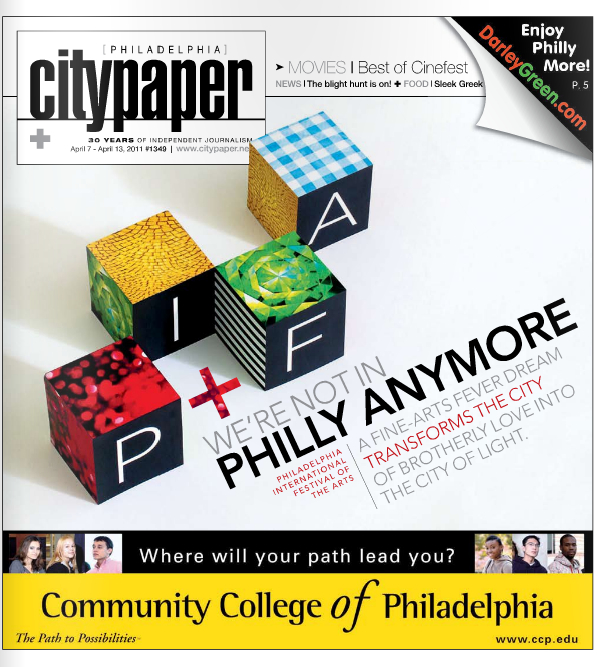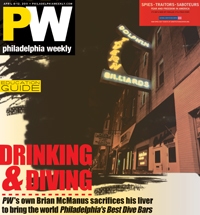 BY DAVE ALLEN Like time, news waits for no man. Keeping up with the funny papers has always been an all-day job, even in the pre-Internets era. These days, however, it’s a two-man job. That’s right, these days you need someone to do your reading for you, or risk falling hopelessly behind and, as a result, increasing your chances of dying lonely and somewhat bitter. That’s why every week PAPERBOY does your alt-weekly reading for you. We pore over those time-consuming cover stories and give you the takeaway, suss out the cover art, warn you off the ink-wasters and steer you towards the gooey center. Why? Because we love you!
BY DAVE ALLEN Like time, news waits for no man. Keeping up with the funny papers has always been an all-day job, even in the pre-Internets era. These days, however, it’s a two-man job. That’s right, these days you need someone to do your reading for you, or risk falling hopelessly behind and, as a result, increasing your chances of dying lonely and somewhat bitter. That’s why every week PAPERBOY does your alt-weekly reading for you. We pore over those time-consuming cover stories and give you the takeaway, suss out the cover art, warn you off the ink-wasters and steer you towards the gooey center. Why? Because we love you!
ON THE COVER
CP: Philly’s about to go French for a month, and I’m about to leave the country. Coincidence? Completely. I’ll actually only be gone a week, but I’m still disappointed that I’ll miss out on the early happenings at the Philadelphia International Festival of the Arts. Deni Kasrel lays out why we’re all going gaga for Gaul.
Anne Ewers, Kimmel Center president and CEO, wanted the facility’s resident companies to be more collaborative. She figured a festival was the way to  go, but she wasn’t sure what form it might take. A colleague, Barbara Silverstein, suggested a festival to celebrate the centennial of Igor Stravinsky’s ballets created for the Ballets Russes — The Firebird, The Rite of Spring and Petrushka — all three of which helped usher in a wave of artistic innovation, first in Paris, and then the world.
go, but she wasn’t sure what form it might take. A colleague, Barbara Silverstein, suggested a festival to celebrate the centennial of Igor Stravinsky’s ballets created for the Ballets Russes — The Firebird, The Rite of Spring and Petrushka — all three of which helped usher in a wave of artistic innovation, first in Paris, and then the world.
When the two women decided to broaden the festival’s scope to embrace other organizations, sticking to Stravinsky seemed too limiting. “When we started to think [about how to embrace] the whole arts and culture community,” Silverstein recalls, “we realized you have to take it back one step from the literal and go with the spirit of Stravinsky and the Ballets Russes. That was the spirit of collaboration, innovation and risk-taking. …We wanted to make sure we could involve as many artists as possible. So the theme of Paris in 1910-1920 is about the spirit of what was going on.”
Paris was a hotbed of creative experimentation back then. Dadaism, Surrealism and other groundbreaking movements emerged. Marcel Proust and Gertrude Stein lit up literature. Pablo Picasso, Henri Matisse and Marc Chagall changed the perspective of painting. Classical music got shaken and stirred by Stravinsky, Erik Satie and Claude Debussy. Circus arts were exploding on the Moulin Rouge.
“It was the birth of a whole new way of thinking about art that lived on,” says Ed Cambron, PIFA executive director. “When you’re looking at a citywide festival, taking inspiration from a group of artists who were in another city, it works beautifully.”
Beaucoup de great features here, too: the exploits of a photographer/muralist/dancer, dalliances with Dada, Questlove going classical. They all sound so good I may just skip my vacation after all. Just kidding — here’s hoping I can catch some good stuff when I get back.
PW: Brian McManus gives us a sneak peek into his book “Philadelphia’s Best Dive Bars,” and the taste that we get, apart from notes of stale sweat and old tobacco, is vivid in some ways and kinda tame in others. He’s exposing a seedy underbelly that few transplants to the city, myself included, have experienced. That’s exciting on a number of levels — journalistic, cultural, alcoholic, etc — and even if I never visit many (or any) of the bars listed, I feel edified all the same.
I’m at DeLeo’s Cafe (405 Dupont St.) on the Manayunk/Roxbourgh cusp, where they don’t take kindly to strangers. Regulars here gaze upon nonregulars with suspicion, some even physically recoiling in the presence of newcomers, hovering nervously around their drinks and waiting uncomfortably for the intruder to leave so they can go back to being themselves. Others take the opposite tack, turning the Asshole up to 11, puffing their chests and cursing loudly with gusto.
 It’s called DeLeo’s Cafe, but it’s not a restaurant. DeLeo’s is unmistakably, inarguably and quintessentially a dive bar.
It’s called DeLeo’s Cafe, but it’s not a restaurant. DeLeo’s is unmistakably, inarguably and quintessentially a dive bar.
But what is a dive, and what makes DeLeo’s one?
I’ve been having this conversation—what makes a dive a dive—a lot over the last year and a half while working on a guide book of Philadelphia dives. In the (according to friends, family and colleagues who’ve received advanced copies) excellent, informative and drop-dead hysterical Philadelphia’s Best Dive Bars: Drinking and Diving in the City of Brotherly Love, I ventured into every corner of our city and cozied up to more than 100 of the finest dives in search of a definitive answer to that very question.
And here it is: In truth, dive bars are like obscenity—you know it when you see it. One man’s dive is another man’s fancy night out or neighborhood hang. That’s just the nature of this beast.
On the other hand, we get a sense of these places, but not of McManus’ experiences there. If he was harrassed, ostracized, or vomited on, we don’t see it in this article, and I wonder if we’ll see in the book as well. Tales of abuse are left to the photographer, poor guy. I feel as though the owners and regulars of these bars can’t be happy that this article and the book it previews are out, which is sure to lead to more stories of greenhorns stumbling into gritty neighborhood hangs. That, too, brings a certain kind of excitement.
INSIDE THE BOOK
CP: L&I: Good for more than busting up bars. Shout-out to Opa, but don’t spike the plate on the floor when you’re done, please. Evocative nonsense: My favorite kind! Augment your reality: When drugs just won’t do the trick.
PW: Everything must go: A big-ass sheriff’s sale. High standards for CineFest: Nothing above a B-plus. Chinese music videos reviewed alongside a restaurant. PIFA shows off pretty intense French affinities.
WINNER: CP takes the title this week for including the play about the famed flatulist Le Petomane among its PIFA coverage. Let ‘er rip, guys.
